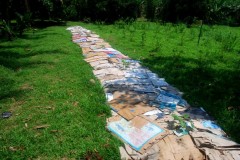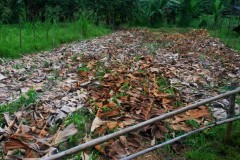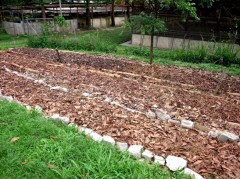Apr 27, 2009
Sheet Mulching - Saves Time and Water
Sheet Mulching is another permaculture technique suitable for tropical countries. At our farm, watering needs can be reduced by half using mulching. Sheet mulching keeps soil moist and prevents weeds from proliferating.
Sheet mulching using cardboard. We are growing pumpkins here and we will proceed to companion plant with serai or lemon grass and then add a layer of compost and leaf mulch on top of the cardboard.
Mulching using banana leaves. Here our objective is to retain soil moisture during the initial stages of napia grass growth and also retain the nutrients from our high-N compost variety during some exceptionally hot days lately.
Our objective is to improve on our previous record of 40 tons of high protein, high omega 3 napia grass per acre per 38 days.
Sheet mulching using cardboard, then topped with compost and dry lalang and leaves. We intend to grow melons and pumpkins here and will companion plant with lemon grass or serai.
19:17 Posted in Permaculture | Permalink | Comments (6) | Tags: permaculture, sheet mulching, no-dig, lazy-man











Comments
We should add that in tropical countries the use of wood-based mulch such as cardboard may attract termites. Constant monitoring may be necessary to prevent widespread infestation.
Posted by: HS | Apr 30, 2009
HS can you say a bit more about your napia planting ? you said 40 tons per acre -> as in 40000kg or imperial tonnes ? and since u say acre i assume it's not hectacre but the imperial 43k+ sq feet ?
flat land or hillside ? local or taiwanese or indian strain ? planting density ? appreciate the pointers. am assuming the land was tilled, watered and goat poopied ?
thanks.
Posted by: azman | May 12, 2009
Azman, 40 metric ton, imperial acre. Local variety and flat land. Alley cropped with nitrogen fixers. Planting stock is 4 ft long and buried horizontally. Distance bet rows is 10 inches. Regular checks to ensure that each node is sprouting, if not, remove and replant. Watered constantly. Application of humus-type compost for root development, and high N compost for growth. High N compost is around 13% N.
Posted by: HS | May 12, 2009
interesting. most seedling i see (on the web offers admittedly) are of the 4-6" cuttings with 3 'eye' and buried at a slight incline Vs horizontal. and the distance between rows is also narrower by half, unless u man between beds as opposed to the distance between two planted stalks.
the rest got too technical for me :p
Posted by: azman | May 13, 2009
hi HS,
can i know the types of grass u feed to yr chickens? can i buy some silky chicks from u? how much will one cost? do u also feed them the same type of grass as for the chicken?
Posted by: patricia tan | May 21, 2009
Hi Patricia,
We seeded up to 30 varieties of grasses and plants. Many are legumes. Of the true grasses, guinea grass is good for chickens when the grass is young. It also has high levels of omega 3. Napia when less than 20 days old is also suitable for chickens and they are also high in omega 3.
I am afraid I do not sell silkies.
Regards
Posted by: HS | May 27, 2009
The comments are closed.